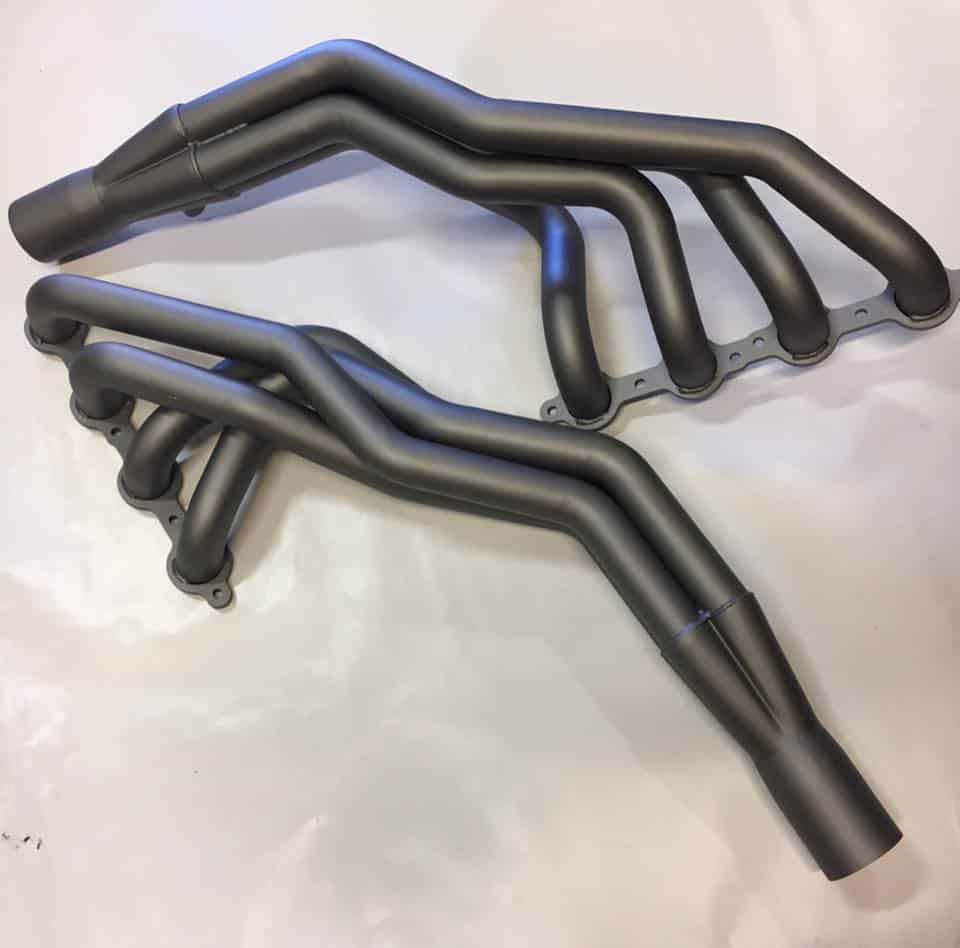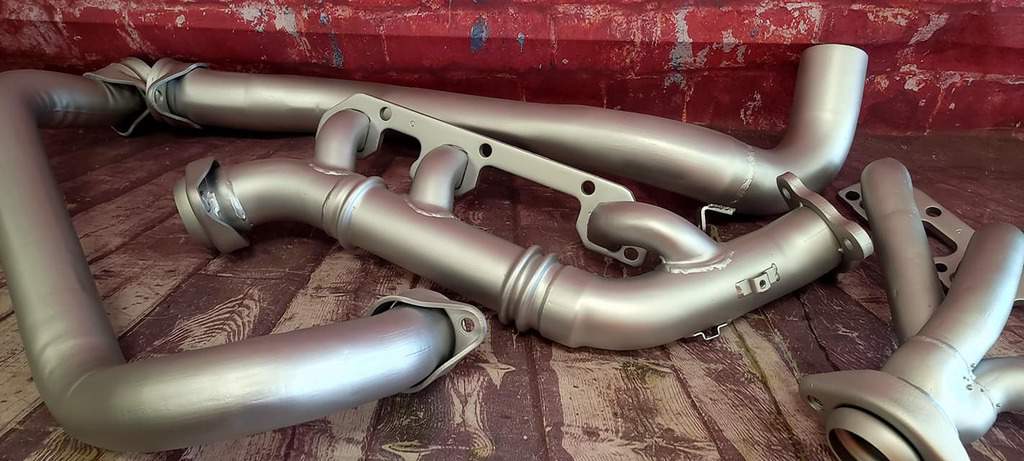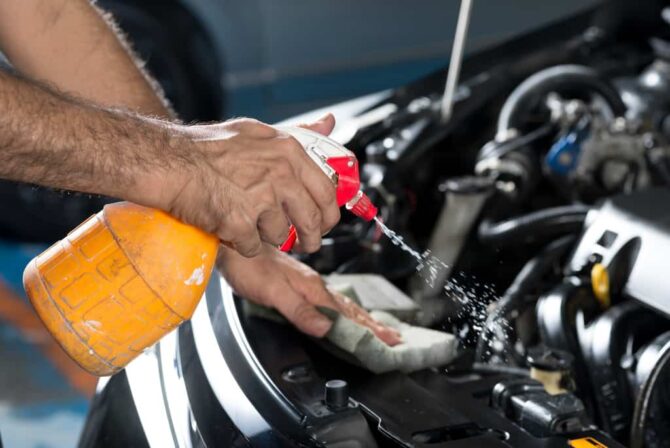When it comes to cars, it’s no secret that nano ceramic coatings work on almost any hard surface. Everything from automotive clear coatings and chrome trim, to headlights, windshields, wheels, and vinyl wraps can be protected by a nano ceramic coating if properly prepped beforehand.
But what about all of those metal exhaust and turbo parts? They too are worthy of protection, but last we checked they were also a tad on the toasty side.
Enter the high-temp ceramic coating spray, in all of its heat resistant glory.
Available in both oven baked and air cured formulas, as well as a myriad of rattle-can options and colors, high-temp ceramic coating sprays fill a much needed gap in the surface protectant market.
Everyone from aftermarket enthusiasts in their garage with spray paint cans in hand, to robotically applied OEM coating manufacturers, and race teams looking to keep temps in check have been swearing by this stuff for decades.
However, this is NOT the same sort of ceramic coating product as the one found within a shiny bottle of Armor Shield IX.
In the information below, we’ll explain how a ceramic coat spray can protect exhaust and turbo parts, and why this protective coating has become so popular. We’ll also dive into the differences between high-temp ceramic sprays and nano ceramic coatings, because while both products are engineered to protect a hard surface, they are quite different in a multitude of ways.
What’s the Difference Between a Nano Ceramic Coating and a Ceramic Coating Spray?

Photo Credit: ATX Powder Coating/Facebook
One of the key differences between high-temperature ceramic coating sprays and a DIY nano ceramic coating like Armor Shield IX, is that one sits on the surface, while the other embeds into it. This doesn’t make one form of ceramic coating better than the other; it just gives each its own inherent strengths and weaknesses.
While both products are engineered to protect the surface from contaminants and physical damage, most nano ceramic coatings cannot sustain extreme temps for long periods of time. High temps are fine, but anything above 440° Fahrenheit for more than a “hot minute” is going to turn that nano ceramic coating into a peeling pile of regret.
In contrast, high-temp exhaust coatings typically do not contain nano-technology, and therefore are unable to embed into all of the microscopic crevices, imperfections, and pours on a surface.
Instead, high-temp ceramic coatings prefer to harden on top of a surface, which makes them ideal for heat shielding, and gives them outstanding pitting and corrosion protection properties. Many exhaust-oriented ceramic coating sprays can withstand exposure to temperatures of 1200° Fahrenheit mark for long periods of time, with extreme temp products handling over 2500° of sustained heat.
Unlike nano ceramic coatings, which are completely clear, the high-temp stuff can be procured in a multitude of colors and paint finishes. From high-gloss candy apple red, to deep matte green, and onward to shades of satin metallic sitting somewhere in between, high-temp ceramic coatings offer an array of hues that deserve to be seen. Am I rhyming again? Thought so…
Quick Nerd Note: In the world of surface coatings, a “mil” is used as a unit of measurement for determining coating thickness levels, and contrary to common belief, mils are NOT synonymous with millimeters. Measuring 1/1000th of an inch, a single mil of high-temp ceramic spray equals 25.4 microns of nano ceramic coating. That means you’d have to apply Armor Shield IX over a dozen times to reach this same level of thickness!
Best Applications for High-Temp Ceramic Coatings

High-temp ceramic paint coatings can be applied to pretty much any surface, including wood, plastic, acrylic, fiberglass, and more. But due to their resistance to heat, these kinds of ceramic coatings truly shine when layered atop heat saturated metal.
Aluminum, stainless steel, carbon steel, chrome, cast iron, magnesium, your ex’s disapproving glare… if it can burn you, chances are it can also be shielded by a high-temp ceramic coating.
Automotive applications aren’t just limited to exhaust components either. Things like air induction and intercooler piping, turbo housings, and valve covers can all be ceramic coated. There have even been advancements in the coating of engine internals, with ceramic coated piston heads being one of the most recent breakthroughs.
The Advantages of Using High-Temp Ceramic Coatings
For automotive performance enthusiasts, investing thousands of dollars in fuel and exhaust system upgrades is just part of the performance puzzle.
In order to protect these expensive go-fast goodies, petrolheads will either opt to have their performance parts professionally powder coated, or they’ll go for the high-temp ceramic coating spray approach.
While the embedded link in the sentence above will provide you with some insight into the world of powder coating, the following list focuses on high-temp ceramic coatings. So choose your path wisely, oh mighty inquisitive one.
Protection

The primary reason why most people choose to have their automotive and motorbike parts ceramic coated, is to protect them from the elements, and to keep heat in-check, which in turn helps hinder corrosion and rust’s inevitable onslaught.
Stock exhaust manifolds, aftermarket headers, turbo housings, and all of the piping that follows is particularly susceptible to these afflictions. Not only do these parts get hotter than a hot tub in the seventh level of Hell, but they also come into exposure with all manner of road grime and undercarriage contaminant.
This is why the more hardcore high-temp ceramic coating products are engineered to reduce damage inflicted by collisions with road debris, rocks, tree branches, and more.
Improved Thermal Cycling

As exhaust oriented parts get hot (we’re talking glowing levels of heat here), and then begin to cool, the metals within these components go through a “thermal cycle.”
While it’s impossible to eliminate thermal cycling entirely, reducing an alloy’s decomposition rate can help prevent things like corrosion and stress fatigue from prematurely appearing.
In exhaust components temperatures often eclipse 1000° Fahrenheit after a few minutes of throttle action, and then climbs from there. A high-temp ceramic coating not only withstands these blazing hot levels of abuse, but it also shields things like electronics and fuel systems from this fiery onslaught.
As for turbo and supercharger components, the application of a high-temperature ceramic coating helps maintain lower surface and internal temperatures, and thus reduces the risk of engine heat-soak issues. This, in turn, reduces thermal cycling, and both extends the lifespan of rapid temperature cycling parts, as well as the components around them.
Appearances

Ever seen a brand-new stainless steel exhaust manifold turn a glorious copper-like hue after it’s been fired up for the first time? Well that gorgeous luster won’t last for long, as discoloring and surface stains are forever eager to form on exhaust parts, which eventually leads to pitting and corrosion.
Applying a high-temp ceramic coating not only improves heat absorption, but it also improves visual appeal by eliminating the risk of rust and corrosion’s unsightly, and potentially detrimental appearance.
With a slew of color and sheen options available, the appeal associated with high-temperature ceramic coating sprays goes well beyond just thermal control and protection.
Performance Perks

Being that a combustion engine must inhale fuel and air prior to sparking a combustive burn, so too must it exhale spent exhaust fumes afterward.
Applying a high-temperature ceramic coating to both the outside and inside of an exhaust system helps improve flow. This means the engine does not have to work so hard, and allows it to work more efficiently, and thus, generate more power.
“Some formulations are stable up to 2000F and require only an ambient cure. Because ceramic coatings need only an ambient cure, and at the same time possess excellent adhesion properties, they are well suited with plastics, wood, polymers, composites and, of course, metals.”
-Crest Coating Inc.
Since a single layer of high-temp ceramic coating spray creates a smooth, consistent finish, and has very high chemical resistance tolerance levels, it has the ability to improve air, fluid, and exhaust flow.
When applied to exhaust components, high-temp ceramic coatings reduce thermal tumbling, so instead of soaking into a specific area, heat is evenly disbursed across a surface. Within an exhaust system, this not only helps prolong longevity and lower temps, but it also eliminates backpressure, which improves flow, and thus increases efficiency and power.
Quick Nerd Note: Although most high-temp spray-on ceramic coatings are intended to perform at temperatures below 1600°F, there are companies like Cerakote that specialize in manufacturing air cured, ready to spray applications that can withstand up to 1800°F of abuse.
The Different Kinds of High-Temp Ceramic Coatings

Photo Credit: Crest Coating Inc.
When it comes to high-temperature ceramic coatings, there a variety of different manufacturers, products, and application methods for you to choose from, with some being far more hardcore than others.
On one end, you have “rattle-can” spray paint DIY high-temp ceramic coatings, which typically are enamel-based, and utilize ceramic resins for heat resiliency. Much like aerosol-based vehicle undercoatings, these sorts of products wallow around in the shallow end of the surface protection pool, and therefore don’t always receive rave reviews from users.
Multi-step pro ceramic coating applications on the other hand, tend to be far more resilient, and thereupon come attached to a far more immense price tag. While spraying a high-temp ceramic coating on one’s own will save a considerable amount of dough, there are plenty of people who are totally fine with handing over their hard-earned cash to a professional installer.
Whichever application method you choose, the following three heat grades are widely recognized as core threshold levels for high-temp ceramic coatings. Knowing which one to spray, and where it will perform best will determine the level of efficiency and longevity a part will experience, so choose wisely, and when in doubt ask a reputable installer for their opinion.
Low Heat Ceramic Coatings – Up to 1300° Fahrenheit
Lower temp ceramic coatings are often used on things like differential housings, valve covers, engine blocks, motor mounts, and radiator stays. Although images of the local auto parts store come to mind when one thinks of low-temp ceramic coating spray, pro installers often utilize milder formulas too.
Medium Heat Ceramic Coatings – Up to 1600° Fahrenheit
Mid-range ceramic coating sprays are the way to go if you are looking to coat an exhaust manifold, a turbo or supercharger system, or the exposed engine externals and mufflers on a motorcycle. Being that it’s typically just a tad more expensive than the average low-temp ceramic coating spray, the medium grade stuff strikes a nice balance between affordability and high-temp functionality.
Extreme Heat Ceramic Coatings – Up to 2000° Fahrenheit
The most hardcore forms of ceramic coating heat protection are engineered specifically for race applications and engine internals. Exhaust manifolds and turbo housings are particularly heat-rich, as they are one of the first things that get hit by the spent fumes produced by the combustion process.
But even then, extreme heat ceramic coatings aren’t always necessary. So unless you are hitting the track every weekend, or are looking to set a new land speed record, opting for this expensive high-temp ceramic coating is completely overkill.
Nano Ceramic Coatings and Exhaust Parts

Despite being able to withstand temps all the way up to 440° Fahrenheit, nano ceramic coatings are not going to offer much on the heat-shielding side of things. In fact, anything beyond that 440° threshold is likely going to result in a rank automotive oriented aroma, followed by a creative string of foul language.
While some reports show that nano ceramic coated exhaust tips hold-up over time, there are just as many people who have seen the ceramic coating on their grapefruit shooter of a muffler begin to peel after a quick run down to the local porn shop. I mean pawn shop. I mean loan shark. Um… right… moving on…
Our advice is that if you plan on hitting your exhaust tips with a layer of Armor Shield IX, coat at your own risk. A tailpipe may be the coolest (and shiniest) part of the exhaust, but even under routine driving conditions it can quickly surpass that 440° Fahrenheit threshold.
Quick Nerd Note: AvalonKing’s product guarantee may be the best in the biz, but it doesn’t cover extreme heat applications, so please don’t come begging for a refund if that little high-temp experiment doesn’t pan-out.
Parting Shots

Despite certain high temp ceramic products possessing a silicon ceramic matrix, and serving many of the same purposes as a DIY nano ceramic coating, that’s about where the similarities between these two ends.
So if you’re hell-bent on ceramic coating your motorbike or automobile with Armor Shield IX, hit things like air intake tubes, aero components, wheels, headlights, painted exterior surfaces, and any other part that doesn’t get super hot. Nano ceramic coatings are also great for brake calipers, valve covers, catch cans and overflow tank reservoirs, and engine shrouds.
However, if the parts you wish to protect absorb a shit-ton of heat, or you are in the mood for a splash of color, it’s probably best to gravitate toward the high-temp ceramic coating spray option.
Either way, always remember to be safe when applying a ceramic coating product, by wearing hand, respiratory, and eye protection. It’s also a good idea to make sure that you are applying the ceramic coating to a clean surface in order to guarantee maximum adhesion and longevity.













3 comments
Dale Pearl
HI Ryan!
Right you are! approximately 2 microns thickness.
HI Ryan!
Right you are! approximately 2 microns thickness.
Ryan M Rogers
Definitely not applied at 2-4 millimeters thick. I believe you meant to state 2-4 mil, which is equivalent to 0.002 – 0.004", or 0.05 – 0.10 mm.
Definitely not applied at 2-4 millimeters thick. I believe you meant to state 2-4 mil, which is equivalent to 0.002 – 0.004", or 0.05 – 0.10 mm.
Josh Scalf
Good to know! I just got my kit today and will be applying Sunday, and wasn’t sure if this would work on my motorcycles exhaust heat shields. Looks like that’s a “no”, so I won’t spend the time on those pieces!
Good to know! I just got my kit today and will be applying Sunday, and wasn’t sure if this would work on my motorcycles exhaust heat shields. Looks like that’s a “no”, so I won’t spend the time on those pieces!